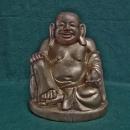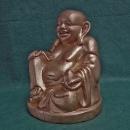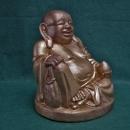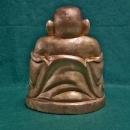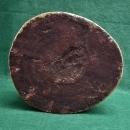Antique 19th Century Chinese Qing Dynasty Gilt Wood Laughing Buddha Budai Figure






$500.00
Antique 19th century Chinese Qing Dynasty extremely well carved ornate gilt wood figure of a laughing Buddha – Budai.
This seated deity wears a loose robe parted in front, revealing his large, protruding belly. His left hand resting on a raised knee, grasping a peach fruit string his right hand is holding the string of a cloth bag at his side.
MEASUREMENTS (approximately):
Height: 25 cm (9.84 inches).
Width at the widest point: 21 cm (8.27inches).
CONDITION: In good condition considering its age, showing age and use, worn in exposed areas, some age cracks in the wood.
Budai: 布袋; is a nickname given to the ancient Chinese monk Qici: 契此) who is often identified with and venerated as Maitreya Buddha in Chan Buddhism, and one of several "uncommitted saints" that became incorporated into the Chan pantheon. He is said to have lived around the 10th century A.D in the Wuyue kingdom.
The name "Budai" literally means "cloth sack”and refers to the bag that he is conventionally depicted as carrying as he wanders aimlessly. His jolly nature, humorous personality, and eccentric lifestyle distinguish him from most Buddhist masters or figures. He is always shown smiling or laughing, hence his nickname in Chinese, the "Laughing Buddha". As Budai is traditionally depicted as overweight and having a huge stomach (a symbol of abundance or forgiveness) and many stories surrounding Budai involve his love of food and drink, he is also referred to as the "Fat Buddha", especially in the Western word.
